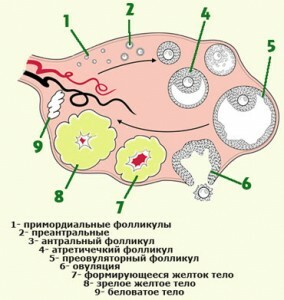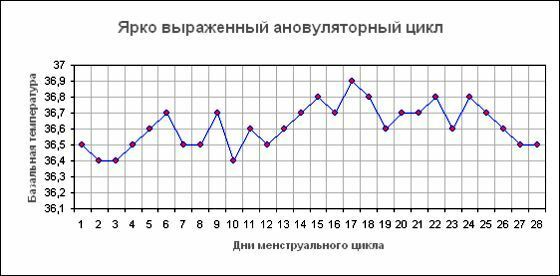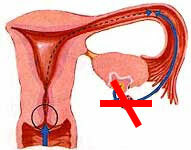The biological meaning of the menstrual cycle is the production of the sex cell, which can lead to the emergence of a new life. This process is called ovulation. But this does not happen in every case. And even the monthly ones in the anovulatory cycle will not always allow to detect this irregularity in the functioning of the reproductive system.
The mechanism of existence of ovulation and anovulation

In contrast tonormal ovulation( as shown in the diagram), the anovulatory cycle does not cause the egg to mature, that is, it is completely absent.
With full health of reproductive organs with the onset of a cycle in the ovaries of several follicles, one is ahead of all. The process helps women's hormones, a different number of which at every stage of its growth helps development. By the middle of the cycle, the follicle reaches the degree of maturation of the female germ cell. His cover bursts, it comes out. If she does not have the opportunity to connect with the sperm, the egg fades, disintegrates. One of its parts is the yellow body, which also produces hormones. Together with the allocated other organs, they contribute to the thinning of the tissues of the uterine mucosa. By the end of the cycle, some of its cells exfoliate and outward, making up a large proportion of menstrual flow. All is outlined by certain time frames, which are repeated on a monthly basis.
The main difference between anovulation is the absence of an egg in this process. It can be natural, as in lactation, the approach of menopause or in adolescence, and pathological. In this regard, the question is natural: are there monthly periods in the anovulatory cycle? The answer is yes, but with reservations. Endometrium, despite the difficulties caused by the decreased volume of hormones, nevertheless develops and sooner or later will be rejected. But what is happening in it has a different character. Moreover, it is influenced by the causes that caused anovulation, among which:
- Problems of various kinds in the work of the ovaries;
- Failures in the thyroid gland, adrenal gland, hypothalamus and pituitary gland;
- Incorrect food intake;
- Excessive physical activity;
- Inflammations and infections of the genitals;
- Stress.
Ultimately, they all lead to hormonal imbalance. On their characteristics depends on how the monthly changes in anovulation.
Effect of anovulation on the

cycle The normal cycle follows a clear pattern, amounting to 21-35 days. At the majority it has average values. The frequent difference in which the anovulatory cycle is characterized, the delay is monthly. To replace the endometrium must reach a certain phase, which is determined by hormones. Their deficiency and incorrect ratio in this case lead to an increase in the time of growth and degradation of the follicle. And if it's really an anovulatory cycle, when waiting for the monthly, depends on its development. They can last from 10 days to 3 months. Deficiency of FSH and LH leads to the fact that the volumes of other sex hormones are also understated. The endometrium changes longer than usual. Through how many during the anovulatory cycle, menstrual cycles depend on the absence of the yellow body, the proper influence on the growth of progesterone before its disappearance.
Anovulation can be temporary or become a permanent feature of critical days. It happens once a year and a healthy woman. It must be understood that the hormonal force majeure caused in these circumstances will not disappear without a trace within 28 days. Therefore, the delay of the monthly after the anovulatory cycle is likely, which reaches 10-15 days. This will be enough for the body to return the ovaries to normal.
Menstruation with anovulation

Anovulatory monthly may have a different type and character. They are established by the mechanism of the causes that caused this phenomenon. Sometimes no external signs are able to indicate the absence of ovulation. But a deficiency of hormones can cause a lack of proper normal support menstruation:
- Does not swell and does not hurt the breast;
- There are no painful sensations in the area of the pubis and lower back;
- Colorless mucus from the vagina, growing in norm before critical days, remains in the same volume due to lack of progesterone;
- The basal temperature retains unchanged values, although in the normal cycle they drop to its peak and jump after.

A lot of excretions during menstruation

Abundant months after the anovulatory cycle are with a high volume of estrogen, maintained for quite a long time. Owing to this, endometrial hyperplasia is often diagnosed, that is, its thickening and proliferation not only at the peak of the cycle, but also towards its end. Naturally, the amount withdrawn with monthly tissues will increase.
Because the endometrium changes differently than usual, the discharge may be with clots of substantial size. Despite the intensity, menstruation is less painful. But repeated anovulation can lead to anemia, as a significant amount of blood is removed. His share in the piggy bank of an ailment is also brought by the increased duration of the process over 7 days. And the woman feels weakness, lack of appetite, other signs characteristic of the syndrome.
Monthly abundant in the anovulatory cycle is supplemented by one more distinctive detail, caused by all the same hormonal problems. Uterus with them acquires a larger size and density, and its neck becomes softer to the touch.
Why when anovulation is low
With regression of the follicle, when it first fixes its increase, and then the growth attenuation and decrease, there is a too slow rise in the volume of estrogens. Mucous uterus is thinned, because there is also a lack of progesterone, which makes it possible to thicken it at a certain stage. Such a malfunction of the processes occurring in the body provokes meager months in the anovulatory cycle. Their volume is less than 50 ml per day and the duration of critical days is also reduced. Uterus with a sparse monthly and this kind of hormonal abnormality shrinks, the cervix acquires cone configuration.
When the monthly go on time

Anovulation with regular menstruation is also likely. The peculiarities of the failure of hormone production are such that their influence is mainly spread to the ovaries. The follicle either does not grow, or, reaching a certain point, begins to develop in the opposite direction. And its regression is accompanied by a decrease in the level of hormones, which provokes bleeding from the genital tract. If these irregular changes are subject to a clear pattern, it will occur cyclically. That is, such bleeding is taken for menstruation, although in fact they are not.
Appearing at a set periodicity, the monthly ones with a repeated anovulatory cycle can externally preserve all the signs of the norm. To establish absence of an oocyte in each of them it is possible if longly to measure a basal temperature. At the initial stage of the cycle, it will be below 37 degrees before the time when ovulation is expected, on the 12-14 day. After this period, in her absence, BT measurements on each day of the last phase of the menstrual period will show that she has either not changed, or has become chaotic. Normally, this does not happen, so this is an obvious sign of anovulation.
Result of anovulation
Unlike regular menstruation, menstruation after the anovulatory cycle is not allowed to conceive. This is their main difference, with which almost all women suffering from this anomaly turn to help. Since anovulation is more often acquired, and not due to birth defects of the reproductive system, early diagnosis is a chance to restore the body to natural functions.
Among the manifestations of many gynecological diseases, doctors call infertility. And anovulation is often his culprit. To infertility is not a life sentence, the appearance of a gynecologist and personal control over the features of menstruation are mandatory not on a case-by-case basis, but regularly. Only a specialist can accurately identify anovulation, its cause and prescribe appropriate therapy.
